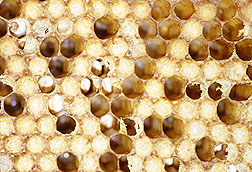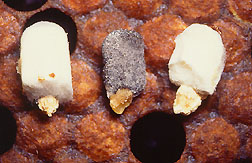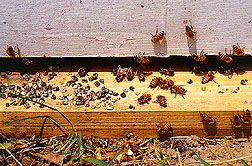Microbes Help Bees Battle Chalkbrood
|
|
Helpful microbes that live in the hives, stored food, and bodies of healthy honey bees enhance many aspects of bee life. Some of the microorganisms produce antibiotics that might hold the key to protecting tomorrow's domesticated honey bees from one of their worst enemies --the harmful Ascosphaera apis fungus that causes chalkbrood disease.
"A natural organism that's already known to occur in hives of healthyhoney bees,"says Agricultural Research Service microbiologist Martha A. Gilliam, "should be easier than a synthetic chemical to register with the federal government as a biological control for chalkbrood."Gilliam is with the ARS Carl Hayden Bee Research Center in Tucson, Arizona.
A microbe-based commercial fungicide might be more effective at penetrating the many layers that protect chalkbrood spores.
"The spores themselves are extremely thick-walled,"says Gilliam. "And they're enclosed within three other protective structures --a sac that houses numerous spores, a spore ball that holds many sacs, and a spore cyst that contains spore balls. Though not impenetrable, these spore cysts are quite difficult for a synthetic chemical to attack."
In her search for beneficial bacteria, yeasts, and molds of the bee world, Gilliam has combed hives of the familiar European honey bee, Apis mellifera, in the United States and abroad. Her sleuthing has yielded some 8,000 strains of microbes that she has painstakingly isolated and identified.
Gilliam's research has shown that some of the microbes live amiably in bees' intestines and help with digestion. Others cause pollen grains --carefully packed into the comb cells by worker bees --to ferment and form beebread that nourishes the colony's brood and young bees. Some microbes act as food preservatives and keep the beebread from spoiling in the hive.
And Gilliam's investigations have revealed that microbes such as certain Penicillium, Aspergillus, and Bacillus organisms apparently produce compounds that inhibit growth of chalkbrood-causing fungal spores.
A Growing Menace
|
|
Chalkbrood attacks only at the larval stage. Bees develop from eggs about the size of a pinhead that are laid in a six-sided brood-comb cell by the queen bee. White, wormlike larvae hatch from the eggs and transform into pupae. Later, young bees emerge from the pupal cocoons.
Larvae may become infected with spores carried in pollen or spread by the nurse worker bees that tend the colony's brood. Larvae mummified by chalkbrood often look like tiny sticks of chalk. Mummies may be white, black, or greyish and mottled.
Since the 1970s, chalkbrood has increased in spread and severity in America. There are no chemicals registered in the United States for its control.
To fight chalkbrood, beekeepers can frequently re-queen their hives; that is, replace the reigning queen with a new one. Other tactics include discarding infected brood combs, keeping hives well-ventilated, and feeding sugar syrup and fresh pollen to keep bees well-nourished, strong, and healthy. Growers should also remove dead mummies that are dumped by nurse worker bees onto the bottom boards of the hive or the ground near the hive.
Chalkbrood damage can affect the pocketbooks of not only beekeepers and growers, but also consumers. Bees are important pollinators of crops ranging from apples to zucchini that are worth more than $10 billion annually in America. An estimated 80 percent of all the food that we eat --or, four out of every five bites --comes from fruits and vegetables pollinated by bees or other insects.
Too, bees produce delicious honey and fragrant beeswax.
Gilliam stores about 1,000 powdered, freeze-dried microbial strains from bee hives in her Tucson lab. When she needs certain cultures for experiments, she revives them by placing the powder on a gel-like bed of nutrients or mixing them with a nutrient broth.
In some tests of the microbes, she uses European honey bees bred for sensitivity to the chalkbrood fungus. Stephen Taber III, now retired from the Tucson lab, bred these bees for the tests.
Gilliam feeds chalkbrood-tainted "pollen patties"to the bees. Any microbes that assist these super-vulnerable bees may be equally useful --if not more so --to European honey bees elsewhere. Her tests include isolates of Mucor spinosus, Rhizopus arrhizus, an as-yet-unidentified Rhizopus, a Penicillium, and Aspergillus tamarii.
Help From the Bees' Genes
Besides aid from microbial allies, some worker bees get help from another source: their genes.
|
|
Some bees have genes that compel them to take on the chore of disposing of dead and dying brood. This limits spread of A. apis spores, as well as the microbes that cause other diseases, such as American and European foulbrood.
Scientists elsewhere have shown that two different genes contribute to this good housekeeping. One drives the bees to remove the little beeswax plug that seals each brood-comb cell. A second gene directs the bees to pull the sick or dead young out of the cell and push them from the nest.
In earlier work, Gilliam and Taber developed a quick, reliable test for accurately detecting these inherited traits. The test also produced more evidence that bees can be selected and bred for this healthful behavior.
For the test, researchers freeze a chunk of brood-containing comb, killing the immature bees, and they place it in the hive. Hygienic bees remove the dead within 48 hours. Sloppy bees take a week or more. Gilliam has used the test to identify dozens of chalkbrood-savvy queens from Arizona hives.
Many bee researchers agree that genetically controlled hygiene habits are the most important factors in chalkbrood resistance or tolerance; microbes play a secondary role. However, Gilliam's research may pinpoint strains of beneficial microbes that can be commercially produced to augment natural populations. These microorganisms may become nearly as important a tool as genetics for boosting bee health.--By Marcia Wood, Agricultural Research Service Information Staff.
Martha A. Gilliam is at the USDA-ARS Carl Hayden Bee Research Center, 2000 E. Allen Rd., Tucson, AZ 85719; phone (520) 670-6380, ext. 121, fax (520) 670-6493.
Visit the Carl Hayden Bee Research Center's home page on the World Wide Web at http://gears.tucson.ars.ag.gov
"Microbes Help Bees Battle Chalkbrood" was published in the August 1998 issue of Agricultural Research magazine. Click here to see this issue's table of contents.









